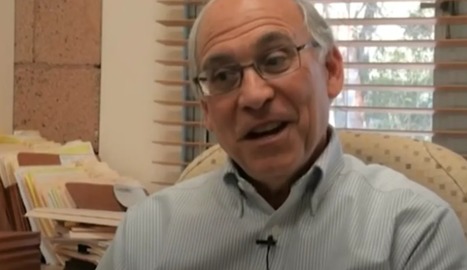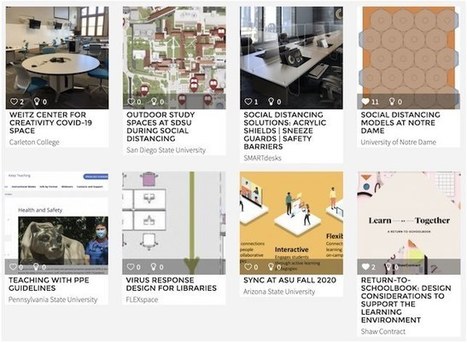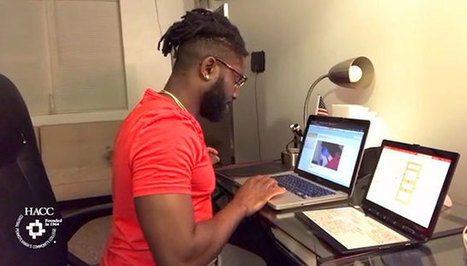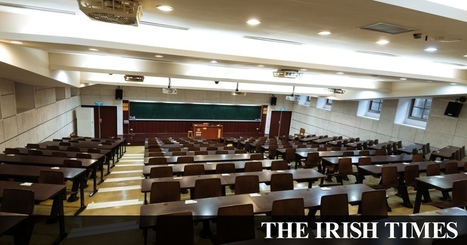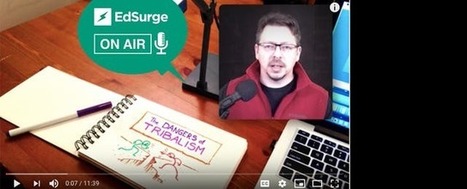 Your new post is loading...
 Your new post is loading...
Mays Imad offers 10 teaching strategies to support students and help them continue to learn during this time of uncertainty.
Author: Simon Hawkesworth – TELT When designing online content, the issue of colour is rarely high on the list of considerations, being left more to the personal preference of the content dev…
On one level, Panicgogy means understanding students' limitations. Some only have smartphones. Some have family responsibilities. But ultimately, panicgogy is about applying compassion to learning.
ABS data shows slump in students was highly gendered, with the number of male students dropping by 21,200
Before you give an Acknowledgement of Country, understand why it's important and how to give one with heart.
Via Peter Mellow
Richard Mayer is one of the most influential educational researchers: His theory of multimedia learning is widely cited, and his resulting principle
Incorporating play into course design can help students to feel more connected with their instructors and with each other, reduce stress, and prime students to engage in learning about emotionally heavy topics.
and whether it’s through procrastination or a wandering mind it’s a sentiment that’s easy to identify with. Individually we might reflect on our use of time and adopt strategies that seek to allay…
The meta‐analysis comparing these 29 traditional—flipped interventions in relation to student achievement showed an overall significant effect in favor of the flipped classroom over traditional lecturing (Hedges' g = 0.289, 95% CI [0.165, 0.414], p < .001). A moderator analysis showed that the effect of the flipped classroom was further enhanced when instructors offered a brief review at the start of face‐to‐face classes. Our qualitative findings suggest that self‐paced learning and more problem‐solving activities were the two most frequently reported benefits that promoted student learning. Based on quantitative and qualitative support, several implications are identified for future practice, such as offering a brief in‐class review of preclass materials. Some recommendations for future research are also provided.
From professors to advisers to career counselors, colleges employ many people responsible for coaching students on how to meet their goals. Bu
What's so important about asking students questions while teaching, and why is it so hard for teachers to do this consistently? What are some of the most time-efficient ways to check all students' understanding, and what's at stake when we fail to formatively assess students?
While teachers are supporting our children diligently, we should acknowledge the outstanding contributions they’re making in keeping our communities running during this pandemic. We must continue to support them in whatever way possible. Read more at Monash Lens.
Carl Hendrick, Wellington College, UK; Author Jim Heal, Deans for Impact, USA One of the difficulties with determining what is effective in a classroom is that very often, what looks like it should work does not and vice versa. Take, for example, the notion of engagement. On the surface, this woul
|
As neuroscience brings greater understanding of the human brain, experts are applying those findings in the classroom to improve how we teach and learn.
Teachers are experimenting with video feedback as a replacement for traditional written mark-ups. There’s evidence that video grading does more to motivate students than written edits — and it can also save teachers time.
The female TA got five times as many negative reviews as the male TA — but they were the same person.
During the past few months, higher education institutions have had an urgent need to respond to the challenges of a pandemic and reconfigure learning spaces quickly with very little room for trial and error. FLEXspace.org has proven to be both a hub for sharing what works and a platform for longer-term research on important questions that impact the future.
The COVID-19 pandemic has had a profound and wide-reaching effect on students, from the quality and nature of the instruction they have received to their social and emotional well-being.
Professors at Play! Bringing FUN back to higher education!
Professors at Play invites educators to explore the transformative power of play in the higher education setting.
This Pennsylvania community college uses a combination of fun, funding and informing to keep their learners in the fold.
The challenges experienced by Ballarat Technical Art School students during the first half of the twentieth century are not dissimilar to the challenges today.
Walking past an open classroom door, I often find myself astonished to hear the professor speaking to college students as if they were third graders. It’s not my place to criticize someone else’s teaching without sitting in on their class properly. But whenever I overhear a faculty member talking down to students, I wonder: Why do you do that? What do you gain from treating your students as antagonists, employees, or children? Do you really think that tone makes students want to come to your class?
Similarly, when supervising new graduate-student instructors, I often have to convince these rookie teachers that their syllabus does not need to contain a litany of rules and regulations, threatening punishment for bad behavior at every turn. “Your position automatically gives you authority in the classroom,” I tell them. “You don’t need to go out of your way assert it with your words.”
Tone matters when you communicate with students. It’s one of the most important ways you can influence your students’ learning environment.
Since August, I’ve been writing about motivation — specifically, the three variables that most contribute to student motivation, as laid out in How Learning Works: Seven Research-Based Principles for Smart Learning, a 2010 book written by current and former staff members of Carnegie Mellon University’s teaching center. Their argument: If you want students to be motivated to learn in your classroom, they need to value the goals you set for them, believe that accomplishing those goals is possible, and feel supported along the way. Having covered the first two, I’ll focus here on that last element — whether the learning environment in your classroom is supportive.
It’s easy to grasp why learning environment would affect student motivation. If the projects you are asking students to complete are difficult (as they should be), if success is not guaranteed (as it shouldn’t be), then the kind of support students will receive along the way becomes a pressing issue. The less supported they feel, the less motivated they will be in pursuit of a course goal. How Learning Works offers a raft of research to show that whether or not students feel included in your course is a prominent indicator of their likelihood of success.
So what can you do to help students feel supported in your classroom?
Change your tone. Like it or not, the way you communicate with students speaks volumes about how you see them and sends a message about their place in the course. Treat students like children and you’re telling them you expect them to act like children. You might as well just say: “I don’t expect you to take full responsibility for this course or its goals.”
How you talk to students during class and office hours, how you call on them to contribute, how you address them in writing on assignment and homework prompts — all of those are opportunities to let students know that they own the course and the institution as much as you do. The more secure they feel in that ownership, the more motivated they will be to work hard.
One indicator of a supportive environment is the degree to which students feel comfortable coming to you for help. Even the tone and phrasing of your syllabus policies can make a difference. According to not-very-surprising research cited in How Learning Works, “Students are less likely to seek help from the instructor who worded those policies in punitive language than from the instructor who worded the same policies in rewarding language.” Hand out a strict, punitive-sounding syllabus and you reveal from the get-go how approachable you are (not very) and how much they can trust you to help when they need it (not much).
Go out of your way, particularly early in the semester, to set the right tone:
Reassure students that it’s OK if they don’t understand everything at first.
When they express uncertainty in class, make sure you respond in a way that encourages others to feel comfortable expressing their uncertainty as well.
Explicitly remind students of your office hours. Keep encouraging them to come to you for extra help. Don’t expect them to automatically take advantage of opportunities for support.
Create an environment that helps students get to know one another. Research has shown that student participation in class is influenced more by peers than by the instructor’s interpersonal style. That is: Whether your students participate in class is affected less by their perception of you and more by their perception that other students in the room are welcoming, encouraging, and attentive. They clam up if they are worried about how their peers will react.
But just because students attribute their own sense of comfort to their peers’ behavior doesn’t mean the instructor is irrelevant. For one, students may not always know exactly why they feel more comfortable in one class rather than another. More important, instructors have a big role to play in shaping the environment of the classroom. You help create the conditions in which students feel welcomed and respected, whether they realize you’re behind it or not.
Here are ways to create that environment:
Set aside time for activities that help students get to know one another and bring their lives into the classroom. For example, instead of just taking attendance in the usual way, do a question roll: Ask students to answer an informal question at the beginning of class after you call out their names. It’s an easy way to help everyone feel more comfortable with each other, and with you.
Look for ways to connect course material with students’ lives, so that they might discuss their experiences and grow closer as a community. Giving that community a chance to develop can be a huge help in your efforts to motivate students.
Sometimes the best teaching strategy is to get out of the way and let your students get to know each other, see what’s valuable in one another, and start trusting each other.
Practice inclusive teaching. To me, inclusive teaching is an approach that seeks both to treat students equally and to recognize the inequalities of the world. If you are serious about creating a welcoming environment that helps every student be motivated to learn, you need to open your eyes to how your usual way of doing things may be making some students feel less than supported.
Everyone has implicit biases. Combating them is difficult precisely because they are implicit — but it’s not impossible. A good place to start: On your syllabus, spell out your policies about the importance of mutual respect and tolerance in the classroom. Even better, make sure your course includes (and centers) identities other than your own. As How Learning Works notes, course content — including not just readings but also “the examples and metaphors instructors use in class and the case studies and project topics we let our students choose” — is important because it sends “messages about the field and who belongs in it.”
Even if you’re not swayed by the social-justice argument for inclusive teaching, the pedagogical argument is pretty strong, too. You are helping your students develop into capable and responsible citizens. Take each of them seriously and work to make sure your classroom environment is designed with all of them in mind. As the research shows, when students feel they belong in your classroom, they are more likely to be motivated to work hard, and more likely to learn.
The environment within your classroom is not completely under your control as the instructor. But there’s enough you can influence to make thinking about course climate a worthy pursuit.
David Gooblar is a lecturer in the rhetoric department at the University of Iowa. He writes a column on teaching for The Chronicle and runs Pedagogy Unbound, a website for college instructors who share teaching strategies. To find more advice on teaching, browse his previous columns here.
Lecturers are opening up about teaching, sharing ideas and taking student engagement seriously
What’s life like after quitting a tenured job as a professor to become a freelance educator, making video courses and podcasts for a living? That’s on
“Any useful statement about the future should at first seem ridiculous.” —Jim Dator, futurist at University of Hawaii-Manoa Here’s somethin
|
 Your new post is loading...
Your new post is loading...
 Your new post is loading...
Your new post is loading...













